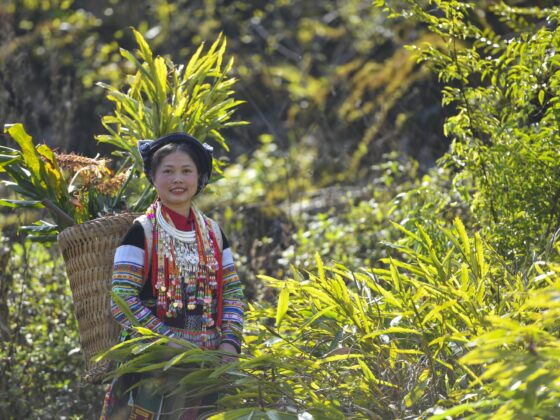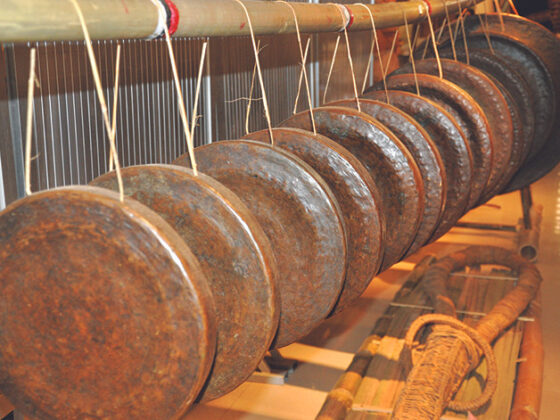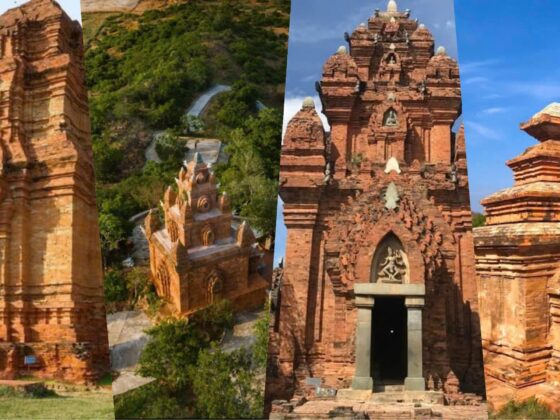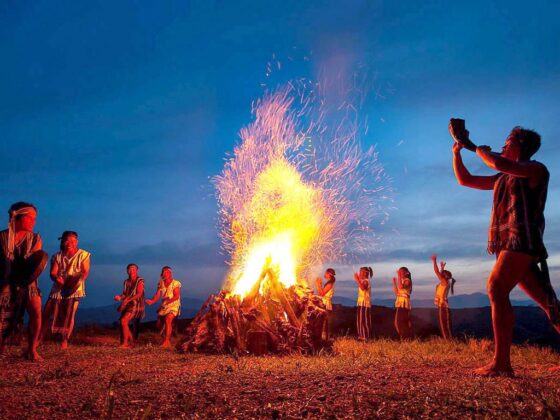Table of Contents Show
To understand the mountains of Ha Giang, you must first understand the people who protect them. The La Chí and Tay, distinct ethnic minorities in Vietnam, are deeply connected to their environment, embodying a harmonious relationship with nature that is reflected in their sustainable practices, cultural heritage, and intimate knowledge of the land. From bamboo weaving and forest foraging to herbal medicine and sustainable farming, these communities thrive by respecting and nurturing the abundant resources around them.
Read more interesting posts here:
- Traditional Vietnamese Herbal Medicine: The Dao People’s Smoke Saunas
- Uncovering the history of the Red River Delta Vietnam
- Workation Vietnam: The Ultimate Guide to Living and Working with Purpose
The unique weaving skills of ethnic minorities in Vietnam like the La Chi

The La Chí people are renowned for their exceptional bamboo weaving skills, which are rooted in tradition and necessity. Bamboo, abundant in the forests of Ha Giang, serves as a versatile material for crafting everything from baskets and mats to intricate decorative items. This craftsmanship not only provides practical uses but also creates beautiful handicrafts that are integral to the cultural identity of many ethnic minorities in Vietnam.
The process of bamboo weaving is a communal activity, often involving families gathering together to share stories, laughter, and skills. This unity fosters strong community ties and reinforces their connection to the land that provides for them. Each woven item tells a story, reflecting the beauty of their surroundings and the artistry of the La Chí.
Foraging traditions among ethnic minorities in Vietnam

The La Chí people possess extensive knowledge of forest foraging, skillfully gathering wild plants, mushrooms, and herbs that are integral to their diet and healing practices. Their understanding of which plants are edible and which have medicinal properties allows them to live sustainably, a trait shared by many ethnic minorities in Vietnam who maintain their health through nature.
Herbal medicine is a cornerstone of the La Chí culture, with many families relying on traditional remedies passed down through generations. They use local herbs to treat common ailments, drawing from their deep understanding of the forest’s offerings to maintain wellness without the need for modern pharmaceuticals.
Sustainable farming by the Tay and other ethnic minorities in Vietnam

Similarly, the Tay people, who inhabit the valleys and lower slopes of Ha Giang, exemplify sustainable farming practices. Known for their rice cultivation, the Tay employ traditional methods that respect the earth and enhance biodiversity. Their terraced fields provide a sustainable means of agriculture that complements the rich ecological systems surrounding them, showcasing the agricultural ingenuity of ethnic minorities in Vietnam.
The Tay also harness bamboo for construction and crafts, mirroring the La Chí’s philosophies on resource use. Their deep connection to their environment is reflected in their rituals and traditions, celebrating both the land and the changing seasons.
How ethnic minorities in Vietnam share a connection to the forests

Both the La Chí and Tay tribes share a profound respect for their forests and mountains. These natural surroundings are not just resources; they are integral to their identities, spirituality, and livelihoods. Their communities engage in harmonious practices that sustain both the environment and their way of life, representing the resilience of ethnic minorities in Vietnam.
Visitors to Ha Giang can explore these rich traditions through guided tours that emphasize sustainable practices and cultural exchange. Engaging with the La Chí and Tay provides insights into their daily lives, including opportunities to partake in foraging trips, attend weaving workshops, or participate in agricultural activities.
Conclusion
The La Chí and Tay peoples exemplify how humanity can coexist with nature in beautiful harmony. Their lifestyles—rooted in bamboo weaving, foraging, herbal medicine, and sustainable farming—offer invaluable lessons on stewardship and respect for the environment. By understanding the deep connections these ethnic minorities in Vietnam maintain with the mountains and forests of Ha Giang, travelers can appreciate the crucial role they play in preserving both the land and their cultural heritage. The legacy of these tribes serves as a reminder that to protect the beauty of nature, we must first honor and understand the people who have dedicated their lives to safeguarding it.
Join our vibrant community on Facebook to share your trekking stories and tips, and don’t forget to like the ExoTrails fanpage for the latest updates and exclusive offers!
Frequently Asked Questions (FAQs)
1. How many ethnic minorities in Vietnam are there?
There are 54 officially recognized ethnic groups in Vietnam, with the Kinh (Viet) people being the majority and the other 53 groups constituting the ethnic minorities in Vietnam.
2. Where do most ethnic minorities in Vietnam live?
The majority of ethnic minorities in Vietnam reside in the mountainous regions of the Northern Highlands (like Ha Giang and Sapa) and the Central Highlands.
3. Can tourists visit the villages of ethnic minorities in Vietnam?
Yes, many villages welcome tourists for cultural exchanges and homestays, provided that visitors show respect for local customs and traditions.










